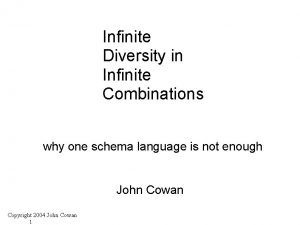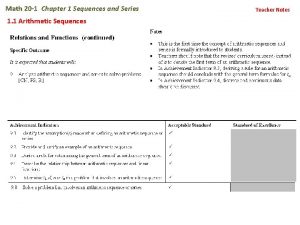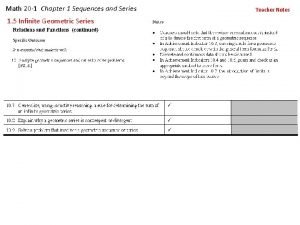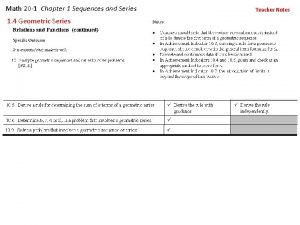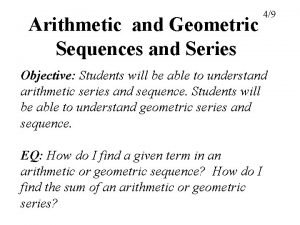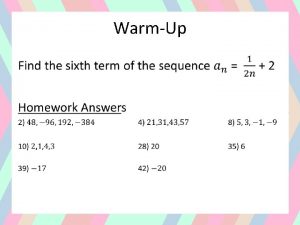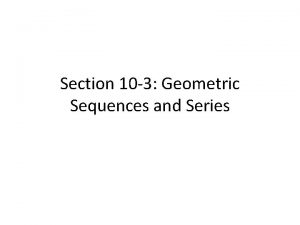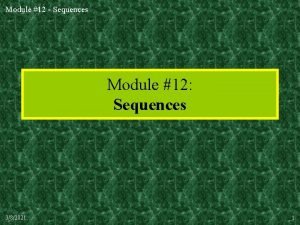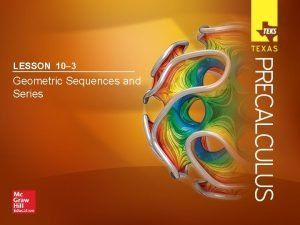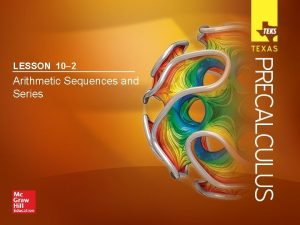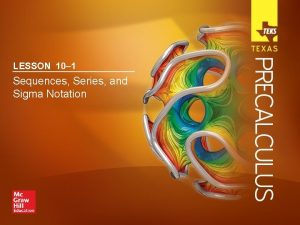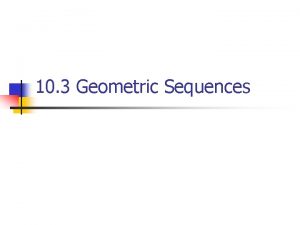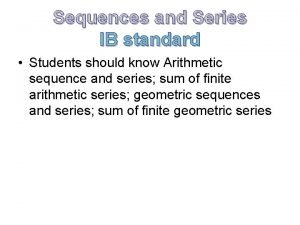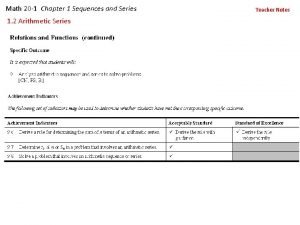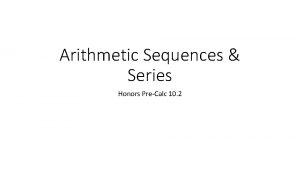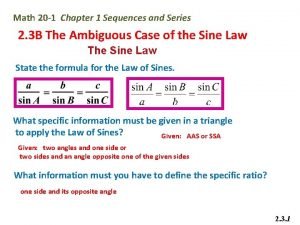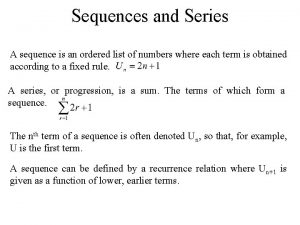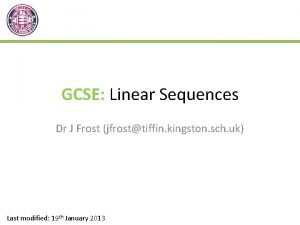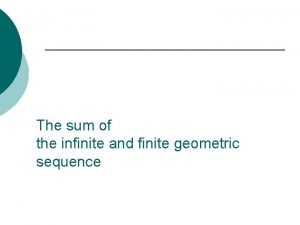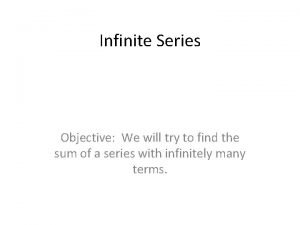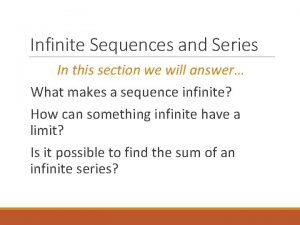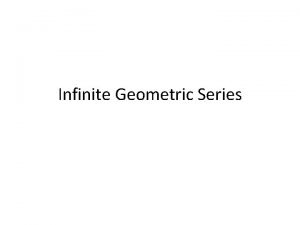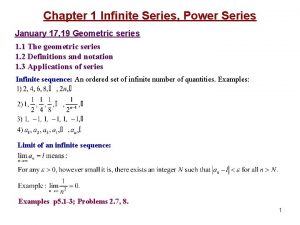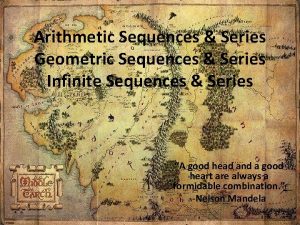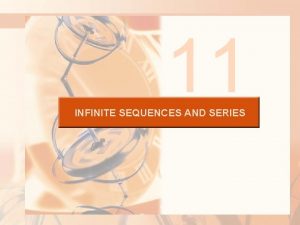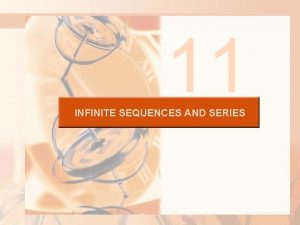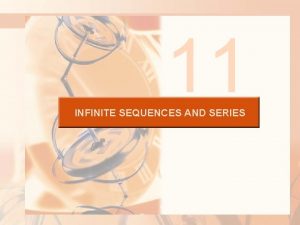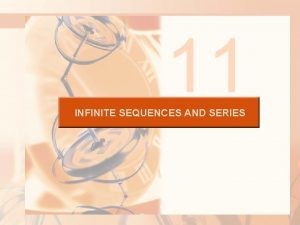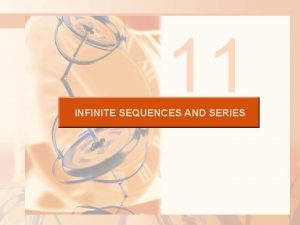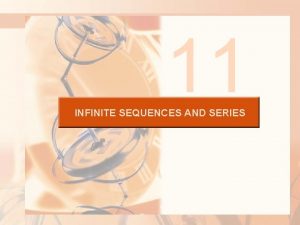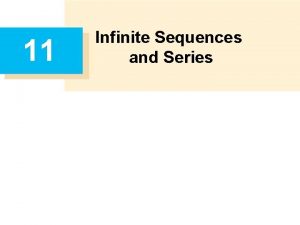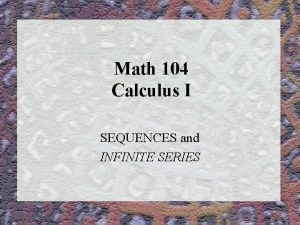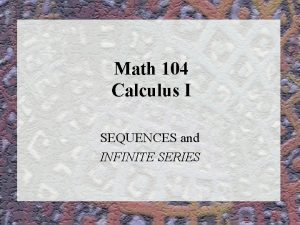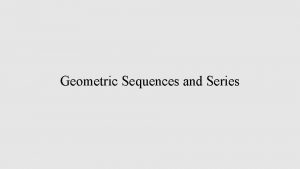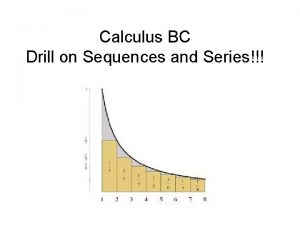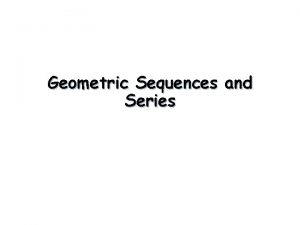Chapter 11 Infinite Sequences and Series Stewart Calculus






























- Slides: 30

Chapter 11 Infinite Sequences and Series Stewart, Calculus: Early Transcendentals, 8 th Edition. © 2016 Cengage. All Rights Reserved. May not be scanned, copied or duplicated, or posted to a publicly accessible website, in whole or in part.

11. 3 The Integral Test and Estimates of Sums Stewart, Calculus: Early Transcendentals, 8 th Edition. © 2016 Cengage. All Rights Reserved. May not be scanned, copied or duplicated, or posted to a publicly accessible website, in whole or in part.

The Integral Test and Estimates of Sums (1 of 11) In general, it is difficult to find the exact sum of a series. We were able to accomplish this for geometric series and the series because in each of those cases we could find a simple formula for the nth partial sum sn. But usually it isn’t easy to discover such a formula. Stewart, Calculus: Early Transcendentals, 8 th Edition. © 2016 Cengage. All Rights Reserved. May not be scanned, copied or duplicated, or posted to a publicly accessible website, in whole or in part.

The Integral Test and Estimates of Sums (2 of 11) We begin by investigating the series whose terms are the reciprocals of the squares of the positive integers: Stewart, Calculus: Early Transcendentals, 8 th Edition. © 2016 Cengage. All Rights Reserved. May not be scanned, copied or duplicated, or posted to a publicly accessible website, in whole or in part.

The Integral Test and Estimates of Sums (3 of 11) There’s no simple formula for the sum sn of the first n terms, but the computergenerated table of approximate values given in the margin suggests that the partial sums are approaching a number near 1. 64 as n ∞ and so it looks as if the series is convergent. n (s_n) = sum_(i = 1)^n(1/(i^2)) 5 1. 4636 10 1. 5498 50 1. 6251 100 1. 6350 500 1. 6429 1000 1. 6439 5000 1. 6447 Stewart, Calculus: Early Transcendentals, 8 th Edition. © 2016 Cengage. All Rights Reserved. May not be scanned, copied or duplicated, or posted to a publicly accessible website, in whole or in part.

The Integral Test and Estimates of Sums (4 of 11) We can confirm this impression with a geometric argument. Figure 1 shows the curve and rectangles that lie below the curve. Figure 1 The base of each rectangle is an interval of length 1; the height is equal to the at the right endpoint of the interval. value of the function Stewart, Calculus: Early Transcendentals, 8 th Edition. © 2016 Cengage. All Rights Reserved. May not be scanned, copied or duplicated, or posted to a publicly accessible website, in whole or in part.

The Integral Test and Estimates of Sums (5 of 11) So the sum of the areas of the rectangles is If we exclude the first rectangle, the total area of the remaining rectangles is smaller than the area under the curve for x 1, which is the value of the integral This improper integral is convergent and has value 1. So the picture shows that all the partial sums are less than Stewart, Calculus: Early Transcendentals, 8 th Edition. © 2016 Cengage. All Rights Reserved. May not be scanned, copied or duplicated, or posted to a publicly accessible website, in whole or in part.

The Integral Test and Estimates of Sums (6 of 11) Thus the partial sums are bounded. We also know that the partial sums are increasing (because all the terms are positive). Therefore the partial sums converge (by the Mono tonic Sequence Theorem) and so the series is convergent. The sum of the series (the limit of the partial sums) is also less than 2: Now let’s look at the series Stewart, Calculus: Early Transcendentals, 8 th Edition. © 2016 Cengage. All Rights Reserved. May not be scanned, copied or duplicated, or posted to a publicly accessible website, in whole or in part.

The Integral Test and Estimates of Sums (7 of 11) The table of values of sn suggests that the partial sums aren’t approaching a finite number, so we suspect that the given series may be divergent. n (s_n) = sum_(i = 1)^n(1/(sqrt(i))) 5 3. 2317 10 5. 0210 50 12. 7524 100 18. 5896 500 43. 2834 1000 61. 8010 5000 139. 9681 Stewart, Calculus: Early Transcendentals, 8 th Edition. © 2016 Cengage. All Rights Reserved. May not be scanned, copied or duplicated, or posted to a publicly accessible website, in whole or in part.

The Integral Test and Estimates of Sums (8 of 11) Again we use a picture for confirmation. Figure 2 shows the curve but this time we use rectangles whose tops lie above the curve. Figure 2 The base of each rectangle is an interval of length 1. The height is equal to the at the left endpoint of the interval. value of the function Stewart, Calculus: Early Transcendentals, 8 th Edition. © 2016 Cengage. All Rights Reserved. May not be scanned, copied or duplicated, or posted to a publicly accessible website, in whole or in part.

The Integral Test and Estimates of Sums (9 of 11) So the sum of the areas of all the rectangles is This total area is greater than the area under the curve for x 1, which is equal to the integral But we know that this improper integral is divergent. In other words, the area under the curve is infinite. So the sum of the series must be infinite, that is, the series is divergent. Stewart, Calculus: Early Transcendentals, 8 th Edition. © 2016 Cengage. All Rights Reserved. May not be scanned, copied or duplicated, or posted to a publicly accessible website, in whole or in part.

The Integral Test and Estimates of Sums (10 of 11) The same sort of geometric reasoning that we used for these two series can be used to prove the following test. The Integral Test Suppose f is a continuous, positive, decreasing function on and let an = f(n). Then the series is convergent if and only if the improper integral is convergent. In other words: (i) If is convergent, then (ii) If is divergent, then Stewart, Calculus: Early Transcendentals, 8 th Edition. © 2016 Cengage. All Rights Reserved. May not be scanned, copied or duplicated, or posted to a publicly accessible website, in whole or in part.

Example 1 Test the series Solution: The function for convergence or divergence. is continuous, positive, and decreasing on so we use the Integral Test: Thus is a convergent integral and so, by the Integral Test, the series is convergent. Stewart, Calculus: Early Transcendentals, 8 th Edition. © 2016 Cengage. All Rights Reserved. May not be scanned, copied or duplicated, or posted to a publicly accessible website, in whole or in part.

The Integral Test and Estimates of Sums (11 of 11) The series 1 The p-series is called the p-series. is convergent if p > 1 and divergent if p ≤ 1. Stewart, Calculus: Early Transcendentals, 8 th Edition. © 2016 Cengage. All Rights Reserved. May not be scanned, copied or duplicated, or posted to a publicly accessible website, in whole or in part.

Example 3 (a) The series is convergent because it is a p-series with p = 3 > 1. (b) The series is divergent because it is a p-series with Stewart, Calculus: Early Transcendentals, 8 th Edition. © 2016 Cengage. All Rights Reserved. May not be scanned, copied or duplicated, or posted to a publicly accessible website, in whole or in part.

Example 4 (1 of 2) Determine whether the series converges or diverges. Solution: The function is positive and continuous for x > 1 because the logarithm function is continuous. But it is not obvious whether or not f is decreasing, so we compute its derivative: Stewart, Calculus: Early Transcendentals, 8 th Edition. © 2016 Cengage. All Rights Reserved. May not be scanned, copied or duplicated, or posted to a publicly accessible website, in whole or in part.

Example 4 (2 of 2) Thus when ln x > 1, that is, x > e. It follows that f is decreasing when x > e and so we can apply the Integral Test: Since this improper integral is divergent, the series is also divergent by the Integral Test. Stewart, Calculus: Early Transcendentals, 8 th Edition. © 2016 Cengage. All Rights Reserved. May not be scanned, copied or duplicated, or posted to a publicly accessible website, in whole or in part.

11. 4 The Comparison Tests Stewart, Calculus: Early Transcendentals, 8 th Edition. © 2016 Cengage. All Rights Reserved. May not be scanned, copied or duplicated, or posted to a publicly accessible website, in whole or in part.

The Comparison Tests (1 of 8) In the comparison tests the idea is to compare a given series with a series that is known to be convergent or divergent. For instance, the series reminds us of the series which is a geometric series with and is therefore convergent. Because the series (1) is so similar to a convergent series, we have the feeling that it too must be convergent. Indeed, it is. Stewart, Calculus: Early Transcendentals, 8 th Edition. © 2016 Cengage. All Rights Reserved. May not be scanned, copied or duplicated, or posted to a publicly accessible website, in whole or in part.

The Comparison Tests (2 of 8) The inequality shows that our given series (1) has smaller terms than those of the geometric series and therefore all its partial sums are also smaller than 1 (the sum of the geometric series). This means that its partial sums form a bounded increasing sequence, which is convergent. It also follows that the sum of the series is less than the sum of the geometric series: Stewart, Calculus: Early Transcendentals, 8 th Edition. © 2016 Cengage. All Rights Reserved. May not be scanned, copied or duplicated, or posted to a publicly accessible website, in whole or in part.

The Comparison Tests (3 of 8) Similar reasoning can be used to prove the following test, which applies only to series whose terms are positive. The first part says that if we have a series whose terms are smaller than those of a known convergent series, then our series is also convergent. The second part says that if we start with a series whose terms are larger than those of a known divergent series, then it too is divergent. The Comparison Test Suppose that (i) If is convergent and an ≤ bn for all n, then (ii) If is divergent and an ≥ bn for all n, then are series with positive terms. is also convergent. is also divergent. Stewart, Calculus: Early Transcendentals, 8 th Edition. © 2016 Cengage. All Rights Reserved. May not be scanned, copied or duplicated, or posted to a publicly accessible website, in whole or in part.

The Comparison Tests (4 of 8) In using the Comparison Test we must, of course, have some known series for the purpose of comparison. Most of the time we use one of these series: • A p-series converges if p > 1 and diverges if p ≤ 1] • A geometric series Stewart, Calculus: Early Transcendentals, 8 th Edition. © 2016 Cengage. All Rights Reserved. May not be scanned, copied or duplicated, or posted to a publicly accessible website, in whole or in part.

Example 1 Determine whether the series converges or diverges. Solution: For large n the dominant term in the denominator is so we compare the given series with the series Observe that because the left side has a bigger denominator. (In the notation of the Comparison Test, an is the left side and bn is the right side. ) Stewart, Calculus: Early Transcendentals, 8 th Edition. © 2016 Cengage. All Rights Reserved. May not be scanned, copied or duplicated, or posted to a publicly accessible website, in whole or in part.

Example 1 – Solution We know that is convergent because it’s a constant times a p-series with p = 2 > 1. Therefore is convergent by part (i) of the Comparison Test. Stewart, Calculus: Early Transcendentals, 8 th Edition. © 2016 Cengage. All Rights Reserved. May not be scanned, copied or duplicated, or posted to a publicly accessible website, in whole or in part.

The Comparison Tests (5 of 8) Note 1: Although the condition an ≤ bn or an ≥ bn in the Comparison Test is given for all n, we need verify only that it holds for n ≥ N, where N is some fixed integer, because the convergence of a series is not affected by a finite number of terms. Stewart, Calculus: Early Transcendentals, 8 th Edition. © 2016 Cengage. All Rights Reserved. May not be scanned, copied or duplicated, or posted to a publicly accessible website, in whole or in part.

The Comparison Tests (6 of 8) Note 2: The terms of the series being tested must be smaller than those of a convergent series or larger than those of a divergent series. If the terms are larger than the terms of a convergent series or smaller than those of a divergent series, then the Comparison Test doesn’t apply. Stewart, Calculus: Early Transcendentals, 8 th Edition. © 2016 Cengage. All Rights Reserved. May not be scanned, copied or duplicated, or posted to a publicly accessible website, in whole or in part.

The Comparison Tests (7 of 8) Consider, for instance, the series The inequality is useless as far as the Comparison Test is concerned because is convergent and an > bn. Stewart, Calculus: Early Transcendentals, 8 th Edition. © 2016 Cengage. All Rights Reserved. May not be scanned, copied or duplicated, or posted to a publicly accessible website, in whole or in part.

The Comparison Tests (8 of 8) Nonetheless, we have the feeling that ought to be convergent because it is very similar to the convergent geometric series In such cases the following test can be used. The Limit Comparison Test Suppose that terms. If are series with positive where c is a finite number and c > 0, then either both series converge or both diverge. Stewart, Calculus: Early Transcendentals, 8 th Edition. © 2016 Cengage. All Rights Reserved. May not be scanned, copied or duplicated, or posted to a publicly accessible website, in whole or in part.

Example 3 Test the series for convergence or divergence. Solution: We use the Limit Comparison Test with and obtain Stewart, Calculus: Early Transcendentals, 8 th Edition. © 2016 Cengage. All Rights Reserved. May not be scanned, copied or duplicated, or posted to a publicly accessible website, in whole or in part.

Example 3 – Solution Since this limit exists and is a convergent geometric series, the given series converges by the Limit Comparison Test. Stewart, Calculus: Early Transcendentals, 8 th Edition. © 2016 Cengage. All Rights Reserved. May not be scanned, copied or duplicated, or posted to a publicly accessible website, in whole or in part.
 9 + 1 = 10
9 + 1 = 10 Integration of power series
Integration of power series Infinite diversity in infinite combinations
Infinite diversity in infinite combinations Chapter 12 sequences and series answers
Chapter 12 sequences and series answers Geometric sequence
Geometric sequence Chapter 1 sequences and series
Chapter 1 sequences and series Chapter 1 sequences and series
Chapter 1 sequences and series Arithmetic and geometric sequences and series
Arithmetic and geometric sequences and series 1^5+2^5+3^5+...+n^5 formula
1^5+2^5+3^5+...+n^5 formula 10-2 practice arithmetic sequences and series
10-2 practice arithmetic sequences and series Unit 10 sequences and series homework 1 answers
Unit 10 sequences and series homework 1 answers 10-3 geometric sequences and series
10-3 geometric sequences and series Module 12 sequences and series answers
Module 12 sequences and series answers Geometric explicit formula
Geometric explicit formula 10-2 arithmetic sequences and series
10-2 arithmetic sequences and series 10-1 sequences series and sigma notation
10-1 sequences series and sigma notation Sum of gp formula
Sum of gp formula Calculus series
Calculus series Series and sequence
Series and sequence Sequences and series math 20-1
Sequences and series math 20-1 Sequences and series games
Sequences and series games How to find arithmetic sequence
How to find arithmetic sequence Sequences and series math 20-1
Sequences and series math 20-1 Series and sequence examples
Series and sequence examples The nth term of a geometric sequence has the form
The nth term of a geometric sequence has the form Dr frost sequences and series
Dr frost sequences and series Geometric series sum formula
Geometric series sum formula Which geometric series converges?
Which geometric series converges? Formula for infinite geometric series
Formula for infinite geometric series Geometric progression formula sum
Geometric progression formula sum L'hopital's rule
L'hopital's rule


